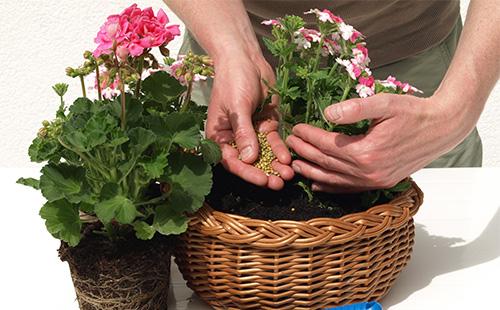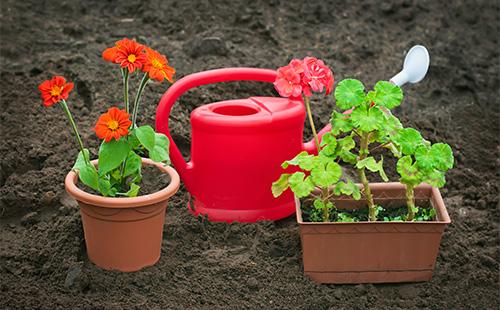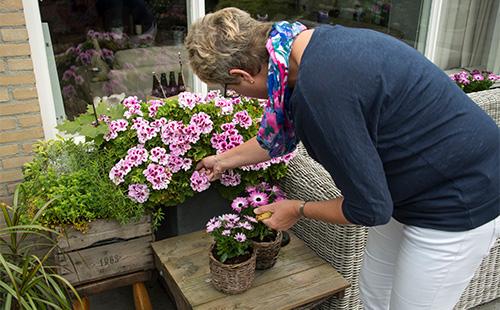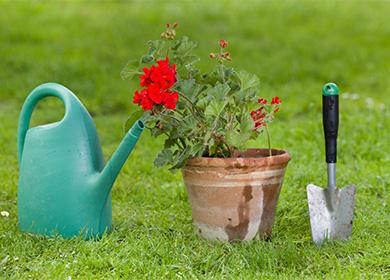The content of the article
Over several decades of cultivation, geranium proved to be an unpretentious, easy to grow plant. Umbrella inflorescences of scarlet, pink, white or colorful can decorate the apartment all year round. Geranium was imported from South Africa, so it is a heat-loving crop. Only when creating favorable conditions does it fully reveal its decorative effect.
Plant description
There are so many varieties of geraniums. All indoor species are divided into two groups.
- Flowering. It stands out with bright, beautiful flowers collected in lush inflorescences.
- Scented. The flowers are not large, not so decorative. It features beautiful and very fragrant leaves. The smell is specific, "for everybody."
They differ in the shape of the bush - the stems are short erect or creeping. The root system is poorly developed in all species. Leaves on long stalks, lobed or dissected. Varieties with cirrus leaves are less common. Their surface is usually pubescent, in the ivy geranium - smooth. The color of the leaves is plain or zonal.
The flowers consist of five rounded petals, gather in lush umbrella or racemose inflorescences. Common colors are white, red, pink, purple. Hybrid varieties with two-color coloring are developed.
Varieties
In addition to several basic varieties grown at home, breeders have bred a lot of hybrid varieties with interesting colors. All geraniums need approximately the same care. The following are considered the most common.
- Zone geranium. The main feature is a two-tone color. The main color is dark green. A brown stripe runs along the edge. The most common species, including plants with simple, semi-double and double flowers. In simple species, flowers consist of five petals. Their number in terry and semi-double species depends on the structure of the flower. The width and intensity of the strip are also different.
- Ivy geranium. Beautiful ampel look. It differs in long hanging shoots up to a meter long. Grown in hanging flower pots. The leaves are smooth, glossy, five-lobed, similar to ivy leaves.
- Geranium "Angel". Ampel variety with shorter shoots. Feature - uncharacteristic for geraniums shape and color of flowers. They resemble "pansies" (viola), gather in beautiful panicle inflorescences.
- Fragrant geranium. A group of plants with a pronounced aroma of leaves. Each variety has its own smell. If you touch the leaves, the aroma intensifies. It does not look so expressive - large pubescent green leaves and ordinary flowers of typical shades.
- King geranium. The most expressive look. It differs in very large colors. Inflorescences are large, paniculate. Coloring of different colors, often with spots, borders, veins of contrasting shades.
- Geranium "Unique". The combined group, which includes hybrids of interesting colors. Expressive flowers with different patterns and veins. The leaves are beautiful, decorative, with a pleasant aroma, less pronounced than fragrant geraniums.
- Dwarf Geraniums. A group of stunted geraniums with abundant flowering. Do not need pruning. Small flowers of different colors, the inflorescences are quite dense.
Care for geraniums: what to consider
Growing geraniums at home is not a hassle. All types of flower are unpretentious, react neutrally to irregular watering, temperature changes. Proper care positively affects the decorativeness, flowering intensity. How to care for potted geraniums?
- Temperature. For stable growth in summer, you need average room temperature. In winter, the plant remains dormant for three months. This period is very important for subsequent flowering. At this time, flower buds are actively being laid. The flower is kept in a cool room at a temperature not exceeding 15 ° C.
- Lighting. It grows better in good light conditions. It reacts neutral to the sun. Some types of ampelous geraniums are recommended to be shaded. The plant is a short day, so artificial lighting in the evening is not required.
- Watering. Watered sparingly. Waterlogging soil flower does not like. The next watering is three days later, after the topsoil has dried out. In winter, watering is minimized. The combination of low temperatures with excessive soil moisture leads to rotting of the stem and roots.
- Air humidity. Spraying is not recommended. An exception can be made for hot summer days. Periodic spraying in the heat is beneficial. Be sure to daily air the room, which contains geraniums. In summer, if possible, move to fresh air. You can add it to the flowerbed along with the pot.
- Top dressing. A couple of months after transplantation, you can feed superphosphate to stimulate flowering. Negatively reacts to the introduction of fresh organics. Rarely fed - not more than once a month with a half dose of fertilizer.
- The soil. The composition of the soil is sheet land, peat, turf, humus and sand. The benefit is the addition of a small amount of charcoal. The main requirements for the soil are water permeability, breathability, friability, neutrality.
- Transfer. Transplanted in the spring. Young plants require an annual transplant, adults only when necessary. The reason for the transplant is the growth of the root system, poor soil conditions, fungal diseases. At the same time, pruning is performed - the stems are shortened to five buds to stimulate the growth of side shoots, the formation of a short, lush bush. Transplanting flowering geraniums is not recommended.
If there are no buds
Usually geranium does not require special conditions for flowering. But the constant content in an unfavorable microclimate can adversely affect the laying of flower buds. The result is sparse flowering or none at all. You can fix the problem by adjusting the care and using the methods of "shock therapy".
Why doesn’t bloom ...
If the geranium does not bloom, first of all, they evaluate the conditions of detention.The following reasons lead to weakening of flowering.
- Lack of light. Geranium is a photophilous plant. A constant lack of light makes it difficult to plant flower buds. They develop poorly or do not form at all.
- Wrong watering. Do not overmoisten the soil. It’s better to dry it a little. High soil moisture is a common cause of rot.
- Big pot. In spacious pots, geranium “eats” - actively grows roots and gains green mass. The pot should be a little cramped.
- Lack or excess of nutrients. Active foliage growth indicates an excess of nitrogen, a lack of phosphorus and potassium. The optimal fertilizer application scheme is once a month with complex universal preparations.
- Incorrect pruning. Regular pruning of up to five buds on the stem causes the growth of lateral shoots, the formation of flower buds on them. After a strong pruning of geraniums, you need rest, cool conditions.
- Lack of rest period. Warm wintering negatively affects flowering. Lack of rest leads to weakening of geraniums.
- Root system issues. Dense soil, frequent and plentiful watering are the main causes of root decay.
- Insects and Diseases. Sick, weakened specimens are not capable of flowering.
... and how to fix it
Making blooming geraniums is pretty easy. Usually enough care adjustments. If this does not help, you can try other methods.
- Cold wintering. It is supplemented with minimal watering and top dressing. After adverse conditions, the geranium blooms. This is a natural method recommended for growing geraniums.
- Temperature differences. At night they take out to the balcony or to the garden. It is impossible to allow freezing.
- Dressing with magnesium sulfate. The substance has a positive effect on the intensity and duration of flowering. Flowers become larger and brighter.
- Iodine. A good remedy for stimulating flowering is pharmacy iodine. In a liter of water add one drop of iodine, mix well. Fertilize on moist earth in the amount of 50 ml per feeding.
- Pruning. Be sure to trim the geranium for lush flowering in order to stimulate it. In this case, a neat bush is formed, the plant is rejuvenated. In autumn, geraniums are cut by about a third. Until December, you need to pinch geraniums, removing the tops of new shoots after the fourth kidney. Strongly elongated, weak shoots are shortened in spring.

Breeding methods
For propagation of geraniums, two methods are used - cuttings and seed cultivation. For sowing, it is better to use seeds purchased in the store. Most indoor geraniums are hybrid varieties. Seeds ripened on them do not carry the characteristics of the mother plant. Therefore, it is better to propagate geranium cuttings - this method is considered more effective and simple.
Cuttings
Cut and root the process at any time of the year. In spring, cuttings root faster. As planting material, cuttings 5-7 cm long with three leaves are used.
Cut cuttings are dried for several hours, the slice is dipped in coal powder. It is better to plant directly in the ground - in the water there is a high probability of decay. The soil is used loose with the obligatory addition of peat and sphagnum. You can make coarse sand.
The substrate is regularly but moderately moisturized. Do not allow water to get on the cuttings - with direct contact with moisture, they rot. The temperature is maintained at a level of 20–22 ˚С. Sheltering geraniums is not necessary.If shelter is used, the greenhouse is aired daily, and the accumulated condensate is removed.
After the emergence of roots, young plants are transplanted into a pot. Be sure to provide for good drainage, monitor humidity. They are kept in a bright place, but they are not placed in the sun - young plants are sensitive to direct sunlight.

Seeds
Seeds purchased in specialized stores germinate quickly even without preliminary soaking. Sown them at the end of winter in a light substrate of peat, turf and sand. The earth is pre-shed with a weak solution of potassium permanganate and dried.
Sow the seeds in moist soil to a depth of about 3 cm. The container is covered with glass, film and placed in a warm, well-lit place. The soil is regularly moistened with a spray bottle. The greenhouse is ventilated, condensate accumulated on the glass and the walls of the container is removed.
Immediately after emergence, the glass is removed, the temperature is reduced to 16–20 ° C. Seedlings can be planted in about two months, when they release three true leaves. The next transplant and the first pinching at the stage of six leaves.
Common growing problems
Diseases, pests, improper care - all this leads to a decrease in decorativeness, weakening and even death of the plant. Below is a table that summarizes the most common growing problems and their causes.
Table - Problems in growing geraniums
| Problem | Possible reasons |
|---|---|
| Leaf defects | |
| Leaves turn yellow | - dry soil; - dry air; - problems with the roots; - whitefly; - bacterial diseases |
| Edges of lower leaves turn yellow | - Lack of nutrition |
| The edges of the leaves dry | - dry air; - sunburn |
| The leaves are deformed | - Spider or multi-claw ticks |
| Leaves wither, become stained, and the stem rots | - lack of magnesium; - cold nights; - rust |
| Red spots appear on the leaves | - stem rot; - leaf spotting |
| Leaves twist, sticky coating appears | - Aphids |
| Geranium dries up | - Prolonged drying of the soil; - powdery mildew; - shields |
| A whitish powdery coating appears, the leaves turn yellow and dry out | - Powdery Mildew |
| Flowering problems | |
| Geranium does not bloom | - Lack of nutrition; - warm wintering; - excess nitrogen; - a spacious pot; - wrong pruning |
| Buds fall | - dry soil; - temperature differences; - excessive watering; - high humidity |
| Holes appear in the petals or unopened buds | - Thrips; - caterpillar leaf-bud-beetle |
| Common problems | |
| Spindle-shaped growth | - lack of light |
| Plant stretching | - An abundance of fertilizing; - lack of light; - thick bush; - lack of pruning and pinching |
| Between watering geranium wilts | - small pot |
| Slow growth | - Lack of trace elements; - improper soil acidity; - whiteflies; - mealybug; - lack of nitrogen |

Common diseases
A healthy, strong plant is resistant to diseases - fungi, viruses. Weakened by improper care, geranium becomes susceptible to pathogens. The table shows frequent diseases, provoking factors and treatment.
Table - Geranium Diseases
| Disease name | Signs | Provocative factors |
|---|---|---|
| Testing | - Brown cork growths on the back of the leaves | - High humidity; - stagnation of water in the roots; - moisture differences; - thrips and ticks |
| Viral diseases | - Yellowness of veins; - loss of color by leaves; - browning of leaves; - growth retardation; - spots of different sizes and colors | - Neighborhood with diseased plants; - weakened state |
| Leaf and stem bacteriosis | - Withering of individual leaves; - yellowness of shoots; - golden brownish oily spots | - Neighborhood with infected flowers; - infected soil |
| Stem and root rot | - Root of the root neck; - faded leaves; - yellowness, wilting of leaves; - root disheveled | - Low acidity of the soil; - high humidity; - soil moisture |
| Verticillus wilting | - Leaves wither; - leaves dry up, but do not fall | - Contaminated soil; - proximity to infected plants |
| Leaf spotting | - rounded brown spots with raised edge | - High humidity; - cold |
| Gray rot | - Wet brown spots; - gray coating | - High humidity; - heat; - waterlogging of the soil |
| Rust Zone Geranium | - Light spots on the outside of the leaves; - brown pads on the underside of the leaves | - Contaminated soil; - proximity to diseased plants; - wet air |
Understanding how to care for geraniums, what conditions are needed for its full growth, it is possible to achieve abundant and prolonged flowering. The variety of geraniums makes it a good flower to collect.

